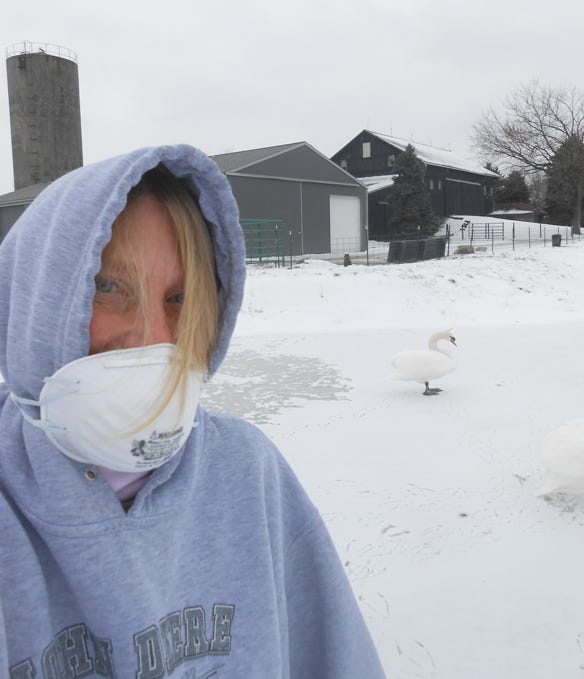March 1, 2017

By Carrie Ann Tomko
Breathe in. Breathe out. Smell that fresh country air — but be cautious. Avoid dust in the air from hay, mold and grain that can negatively impact your health and lead to a chronic lung condition.
Farmer’s Lung, otherwise known as hypersensitivity pneumonitis, is caused by dust—simple dust. Dust is everywhere, right? Still, consider that dust can lead to a serious lung condition, existing in 30 out of 1,000 farmers, namely found in dairy cattle farmers. Most cases are diagnosed in cold, damp periods when farmers are feeding stored hay and feed to their livestock.
The cause of Farmer’s Lung is dust inhalation. Dust can be found in a number of agricultural sources. Hay bales that are cracked open can emit a cloud of dust. Mold can grow on stored grain crops and become air-borne when stirred up. A blender in motion can spew dust particles. The dust is so fine that it easily reaches the inner lung tissue, called the alveoli.
In certain individuals, the alveoli cannot combat this intrusive material, and thus the acute reaction can appear as mild as a cold and cough, or as dramatic as a bout of pneumonia. In either case, the lungs, if left untreated, can fill with scar tissue, called fibrosis, which is permanent. Therefore, detection and treatment are important to eliminating permanent scarring of the lungs.
Symptoms
Initially, symptoms may appear to be a nagging cold and cough, or even a flu or pneumonia. Examples of the acute symptoms of Farmer’s Lung include irritating cough, runny nose, fever, chills, crackling breathing, shortness of breath. These symptoms can run their course and dissipate, or become a chronic condition.
While many acute attacks, as described above, are noticeable, the chronic form is more common. It develops gradually with a variety of symptoms: chronic cough, progressively increasing shortness of breath, occasional fever, loss of energy and constant fatigue. The loss of energy and fatigue is due to the lack of oxygen getting to all parts of the body, as the exchange of gases in the lungs becomes less and less efficient.
Treatment
Although there is no cure for Farmer’s Lung, some treatment options are available. Bed rest and oxygen therapy can have a positive impact on chronic conditions. Inhalers are also available for acute attacks. Prevention is the only answer, which means avoidance of dust. Suggestions to limit dust inhalation are as follow:
• Adequately dry hay and crops before storing to avoid mold growth and thus mold dust.
• Wear a mask or respirator that prevents dust inhalation.

PROTECTION: Wearing a mask around the farm helps prevent inhaling dust.

• Provide as much ventilation as possible when working in dusty, confined areas.
• If possible, perform dusty work outside for increased ventilation.
• When opening a hay bale, keep a safe distance by breaking it with a tractor whenever possible. If it is necessary to be hands-on, use a pitch fork, rather than bending close to the bale to avoid inhalation.
City girl truly turns into a farmer
I was diagnosed last spring with Farmer’s Lung. I’m officially no longer a “city girl,” but a “farmer.”
Not growing up on a farm, it was a dream come true to become a farmer and have the opportunity to raise beef cattle.
In my case, I was diagnosed initially with pneumonia. The cough that I endured was severe. And my chest X-ray revealed abnormalities, despite never having smoked. Being hands-on in the barn, the constant dust exposure was the contributing factor to my debilitating cough. My energy levels and lung capacity were depleted for a six weeks. After bed rest, I regained my energy and thought I had licked the pneumonia.
A bump in the road
After getting back into farm activities, I accidentally inhaled a large quantity of dust and experienced an abrupt case of pneumonia-like symptoms again. The attack came on so suddenly that I was rushed to an urgent care center. I eventually saw a pulmonary specialist who said the coughing and wheezing was a result of hyper-inflated lungs, which brought chest pain. I was then diagnosed with Farmer’s Lung.
I now wear a mask to block the dust from my lungs, and only occasionally use an inhaler if an uncontrollable cough is triggered. Using preventive measures, I participate fully in barn activities, hay fields and pastures with the cattle herd.
I can’t imagine a day without having calf spit on my hands, making hay in the warm sunshine or wrapping haylage bales late into the night. I’m proud to be a beef cattle farmer; unfortunately, I have the lungs to prove it.
Tomko writes from Rittman.
You May Also Like




